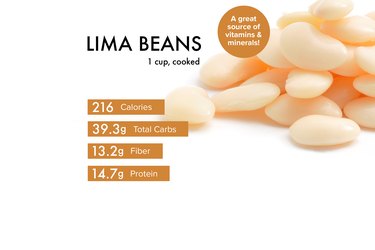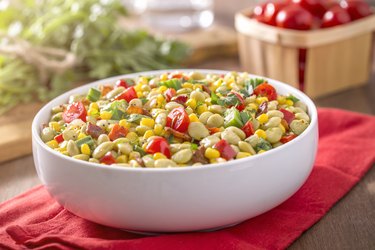
Sometimes called butter beans, lima beans have a starchy, creamy taste and texture and can be found in a range of sizes and colors.
In addition to the most common off-white and green lima beans, you can also find red, brown, black, purple and speckled varieties, according to the Genetic Improvement of Vegetable Crops. The pod of the lima bean is flat, oblong and slightly curved. Within these pods, two to four kidney-shaped seeds, or lima beans, reside.
Video of the Day
Video of the Day
Lima beans, thought to be named after the capital of Peru, originated in South America and then spread north into Central America, North America and eventually worldwide. You may have heard of succotash, a Native American dish that features lima beans and corn, which is one of the most popular associations with lima beans in the United States.
Lima beans are available frozen, dried or canned, but be sure to look for them at your local farmers' market in the summer and fall when they are in season. They are nutrient powerhouses, packed full of vitamins, minerals and macronutrients, making them a healthy and delicious addition to your diet.
Lima Bean Nutrition Facts
One cup of lima beans is equal to a single serving. One cup of lima beans contains:
- Calories: 216
- Total fat: 0.7 g
- Cholesterol: 0 mg
- Sodium: 3.8 mg
- Total carbs: 39.3 g
- Dietary fiber: 13.2 g
- Sugar: 5.5 g
- Added sugar: 0 g
- Protein: 14.7 g
Lima Beans Macros
- Total fat: One cup of cooked lima beans has 0.7 grams of total fat, which includes 0.3 grams of polyunsaturated fat, 0.06 grams of monounsaturated fat, 0.2 grams of saturated fat and 0 grams of trans fat.
- Carbohydrates: One cup of cooked lima beans has 39.3 grams of carbohydrates, which includes 13.2 grams of fiber and 5.5 grams of natural sugars.
- Protein: One cup of cooked lima beans has 14.7 grams of protein.
Vitamins, Minerals and Other Micronutrients
- Copper: 49% Daily Value (DV)
- Manganese: 42% DV
- Folate: 39% DV
- Thiamin (B1): 25% DV
- Magnesium: 19% DV
- Vitamin B6: 18% DV
- Phosphorous: 17% DV
- Zinc: 16% DV
- Selenium: 15% DV
- Choline: 11% DV
- Potassium: 20% DV
- Iron: 25% DV
- Lima beans have trace amounts of vitamin K and calcium.
- Lima beans are not a good source of vitamins A, C and D (0% DV).
Health Benefits of Lima Beans
Like all legumes, lima beans have a rich and varied nutrient profile. Lima beans contain a wide range of vitamins, minerals and fiber.
1. Lima Beans Are High in Iron
Iron is a vital part of your diet, an essential component of red blood cells, which help deliver oxygen throughout the body, keep connective tissues health and work with muscle metabolism, according to the National Institutes of Health.
Low levels of iron may lead to iron deficiency or iron deficiency anemia, with symptoms such as fatigue, weakness, gastrointestinal distress, immunity issues and impaired cognitive function.
There are two main forms of iron: heme, which is found in animal products, and non-heme, which comes from iron-fortified foods or plant-based foods including lima beans. One cup of cooked lima beans provides 25 percent of the DV for iron, making it an excellent means to reach your daily dose in a delicious way.
Tip
Pair your lima beans with foods high in vitamin C, such as citrus fruit and bell peppers. Non-heme iron and vitamin C work together synergistically to enhance the bioavailability of the iron which, in turn, helps your body absorb more.
2. Lima Beans Can Help With Weight Loss
Lima beans are an excellent source of plant-based protein and dietary fiber, a dynamic duo that works together to support healthy weight-loss goals and to maintain a healthy weight.
Eating a plant-forward diet full of whole fruits, vegetables, legumes and nuts has been shown to be an effective strategy in the treatment of obesity, according to an article published in the November 2018 issue of Nutrition and Diabetes. The 16-week study found that plant-based protein was associated with improvements in body weight, body composition and insulin resistance.
Lima beans and other legumes have a higher protein content than many other plant-based foods, making them an optimal choice for vegans, vegetarians and anyone looking to add more plant-based foods to their daily diet.
What's more, higher intakes of fiber are linked to lower body weights, per an April 2013 study in Nutrients. Dietary fiber creates bulk, helping to keep you full and your intestinal tract running smoothly. Increasing fiber intake to 30 grams per day has been shown to be an effective approach to weight loss, per a February 2015 report in the Annals of Internal Medicine.
Clocking in at 13.2 grams of fiber and 14.7 grams of protein per serving, lima beans are a great way to help reach your weight-related goals, whatever those may be.
3. Lima Beans Are Linked to Better Brain Health
Research is exploring how the essential nutrient choline may have lasting effects on brain health and cognitive decline.
Among its many roles, choline is needed for regulating brain and nervous system functions and preserving the integrity of cells. According to the National Institutes of Health, most people don't get enough choline. While plant-based sources typically contain less of the nutrient than animal-based sources, one serving of lima beans provides 11 percent of the DV, making it a good way to help get your daily dose.
Lima Beans Health Risks
Raw lima beans contain cyanogenic glycosides, which are compounds that release cyanide when damaged as a means to protect the plant, according to Oregon State University.
That's why it's important to never eat lima beans raw and be sure to cook them properly, which will destroy the enzymes that release the cyanide. Boiling them for at least 30 minutes or soaking them in water for 24 to 48 hours prior to cooking are both great ways to ensure the lima beans are safe to eat.
Food Allergies
Lima beans are generally regarded as safe for most people to eat. However, because soy is a common allergen and part of the legume family, some people with soy allergies may also experience allergic reactions to lima beans, according to the Cleveland Clinic.
If you have soy allergies, it is recommended to speak with your health professional regarding lima beans and other legumes.
Drug Interactions
There are currently no known drug interactions. Be sure to discuss any medication and food interactions with your health professional.
Lima Bean Preparation and Useful Tips

Lima beans can be found year-round in frozen, dried and canned versions, but hit their peak season in the summer and fall. Follow these tips to prepare any version of lima beans you prefer:
Frozen lima beans will stay fresh in the freezer for up to six months. Simply thaw and add to your favorite recipes.
Dried lima beans will stay at a good quality for about two to three years. Make sure they are in a container with a tight-sealing lid and stored in a cool, dry place to prevent them from drying out. When preparing dried lima beans:
- Inspect your dried beans, looking for any rocks or pebbles to discard and ensuring beans are not broken.
- Soak beans overnight, making sure beans are fully covered with water.
- After soaking, rinse and drain the beans until the water runs clear.
- Place in a pot, fill and cover the lima beans with water, and cook at a simmer until beans are tender, approximately one hour.
- Use cooked lima beans in soups, stews, salads, succotash and more!
Canned lima beans are already cooked and require no further cooking. They can be eaten cold or reheated depending on the recipe and taste preferences. Make sure to drain and rinse canned lima beans before using them, which helps to wash away some of the added sodium found in canned goods.
Fresh lima beans can be shelled, blanched and frozen for future recipes or cooked until soft — about 40 to 60 minutes depending on their size — for immediate use.
Lima beans can be used in a wide variety of dishes and added to salads, grains, soups and stews. Here are two quick recipes to get you started:
- Make succotash: Sauté onions and garlic and then add to a bowl with corn, olive oil, salt and pepper. Add in other favorite chopped veggies and vinaigrette if you like.
- Try a bean-veggie bake: Baked lima beans are a great way to use up vegetables and have a colorful dish on your table. Simply place lima beans with a variety of vegetables, including onions, carrots, celery and greens in a baking dish. Mix in some canned tomatoes, salt and pepper and enough broth to cover all the ingredients. Then, place foil on top of the dish, and bake at 350 degrees Fahrenheit for 45 to 60 minutes until beans are tender.
Alternatives to Lima Beans
There are many varieties of beans available. Lima beans can easily be swapped out for other varieties, including pinto, kidney, black and cannellini beans as well as edamame.
- Genetic Improvement of Vegetable Crops: "Lima bean: Phaseolus lunatus L."
- My Food Data: "lima beans"
- National Institutes of Health: "Iron Fact Sheet for Health Professionals"
- Nutrition and Diabetes: "A plant-based diet in overweight individuals in a 16-week randomized clinical trial: metabolic benefits of plant protein"
- Nutrients: "Fiber and Prebiotics: Mechanisms and Health Benefits"
- Annals of Internal Medicine: "Single-Component Versus Multicomponent Dietary Goals for the Metabolic Syndrome: A Randomized Trial"
- National Institutes of Health: "Choline Fact Sheet for Health Professionals"
- Oregon State: "Should I worry about the cyanide in lima beans?"
- Cleveland Clinic: "Soy Allergy"